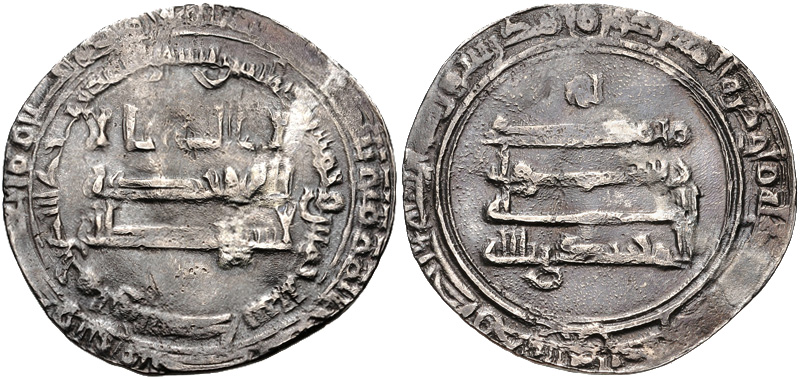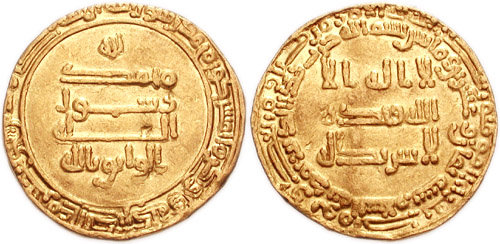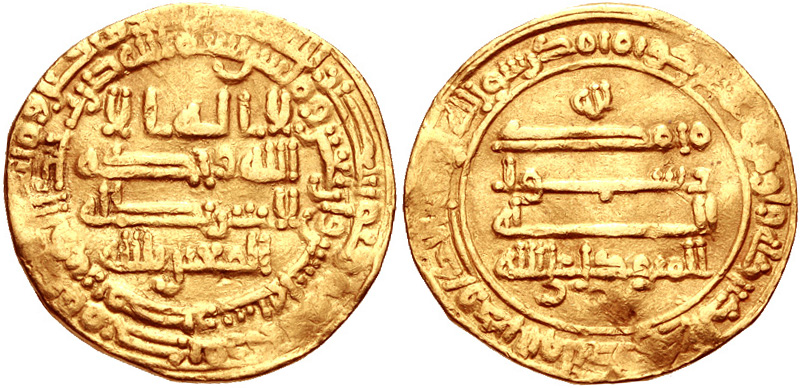|
Al-Muhtadi
Abū Isḥāq Muḥammad ibn al-Wāthiq ( ar, أبو إسحاق محمد بن هارون الواثق; – 21 June 870), better known by his regnal name Al-Muhtadī bi-'llāh (Arabic: , "Guided by God"), was the Caliph of the Abbasid Caliphate from July 869 to June 870, during the "Anarchy at Samarra". Early life Al-Muhtadi was the son of Abbasid caliph al-Wathiq. He was born in 833. Al-Muhtadi's mother was Qurb, a Greek slave. After the death of his father, Caliph al-Wathiq () in August 847, there were some officials who wanted to elect the young al-Muhtadi as caliph, but in the end, their choice fell on his uncle, al-Mutawakkil (). Background Despite the successes of caliph al-Mu'tazz, He could not overcome the main problem of the period: a shortage of revenue with which to pay the troops. The financial straits of the Caliphate had become evident already at his accession—the customary accession donative of ten months' pay for the troops had to be reduced to two for lac ... [...More Info...] [...Related Items...] OR: [Wikipedia] [Google] [Baidu] |
Salih Ibn Wasif
Salih ibn Wasif ( ar, صالح بن وصيف; died January 29, 870) was a Turkic officer in the service of the Abbasid Caliphate. The son of Wasif, a central figure during the Anarchy at Samarra, Salih briefly seized power in the capital Samarra and deposed the caliph al-Mu'tazz in 869, but he was later defeated by the general Musa ibn Bugha and killed in the following year. Early career Salih was the son of Wasif al-Turki, a Turkish general who had risen to prominence during the caliphate of al-Mu'tasim (r. 833–842). Together with his ally, the fellow Turk Bugha al-Sharabi, Wasif had been involved in the assassination of al-Mutawakkil (r. 847–861). During the chaotic period that followed al-Mutawakkil's death (the Anarchy at Samarra, 861–870), Wasif and Bugha were among the principal figures in the events that transpired. They held a strong degree of influence over the central government and were responsible for the downfall of several caliphs and other prominent ... [...More Info...] [...Related Items...] OR: [Wikipedia] [Google] [Baidu] |
Anarchy At Samarra
The Anarchy at Samarra () was a period of extreme internal instability from 861 to 870 in the history of the Abbasid Caliphate, marked by the violent succession of four caliphs, who became puppets in the hands of powerful rival military groups. The term derives from the then capital and seat of the caliphal court, Samarra. The "anarchy" began in 861, with the murder of Caliph al-Mutawakkil by his Turkish guards. His successor, al-Muntasir, ruled for six months before his death, possibly poisoned by the Turkish military chiefs. He was succeeded by al-Musta'in. Divisions within the Turkish military leadership enabled Musta'in to flee to Baghdad in 865 with the support of some Turkish chiefs ( Bugha the Younger and Wasif) and the Police chief and governor of Baghdad Muhammad, but the rest of the Turkish army chose a new caliph in the person of al-Mu'tazz and besieged Baghdad, forcing the city's capitulation in 866. Musta'in was exiled and executed. Mu'tazz was able and energetic, ... [...More Info...] [...Related Items...] OR: [Wikipedia] [Google] [Baidu] |
Al-Mu'tamid
Abu’l-ʿAbbās Aḥmad ibn Jaʿfar ( ar, أبو العباس أحمد بن جعفر; – 14 October 892), better known by his regnal name Al-Muʿtamid ʿalā ’llāh (, "Dependent on God"), was the Caliph of the Abbasid Caliphate from 870 to 892. His reign marks the end of the "Anarchy at Samarra" and the start of the Abbasid restoration, but he was largely a ruler in name only. Power was held by his brother al-Muwaffaq, who held the loyalty of the military. Al-Mu'tamid's authority was circumscribed further after a failed attempt to flee to the domains controlled by Ahmad ibn Tulun in late 882, and he was placed under house arrest by his brother. In 891, when al-Muwaffaq died, loyalists attempted to restore power to the Caliph, but were quickly overcome by al-Muwaffaq's son al-Mu'tadid, who assumed his father's powers. When al-Mu'tamid died in 892, al-Mu'tadid succeeded him as caliph. Life The future al-Mu'tamid was a son of Caliph al-Mutawakkil () and a Kufan slave girl c ... [...More Info...] [...Related Items...] OR: [Wikipedia] [Google] [Baidu] |
Abbasid Samarra
Samarra is a city in central Iraq, which served as the capital of the Abbasid Caliphate from 836 to 892. Founded by the caliph al-Mu'tasim, Samarra was briefly a major metropolis that stretched dozens of kilometers along the east bank of the Tigris, but was largely abandoned in the latter half of the 9th century, especially following the return of the caliphs to Baghdad. Due to the relatively short period of occupation, extensive ruins of Abbasid Samarra have survived into modern times. The layout of the city can still be seen via aerial photography, revealing a vast network of planned streets, houses, palaces and mosques. Studies comparing the archeological evidence with information provided by Muslim historians have resulted in the identification of many of the toponyms within the former city. The archeological site of Samarra was named by UNESCO as a World Heritage Site in 2007, calling it "the best-preserved plan of an ancient large city." The modern city bearing the same ... [...More Info...] [...Related Items...] OR: [Wikipedia] [Google] [Baidu] |
Al-Wathiq
Abū Jaʿfar Hārūn ibn Muḥammad ( ar, أبو جعفر هارون بن محمد المعتصم; 17 April 812 – 10 August 847), better known by his regnal name al-Wāthiq bi’llāh (, ), was an Abbasid caliph who reigned from 842 until 847 AD (227–232 AH in the Islamic calendar). Al-Wathiq is described in the sources as well-educated, intellectually curious, but also a poet and a drinker, who enjoyed the company of poets and musicians as well as scholars. His brief reign was one of continuity with the policies of his father, al-Mu'tasim, as power continued to rest in the hands of the same officials whom al-Mu'tasim had appointed. The chief events of the reign were the suppression of revolts: Bedouin rebellions occurred in Syria in 842, the Hejaz in 845, and the Yamamah in 846, Armenia had to be pacified over several years, and above all, an abortive uprising took place in Baghdad itself in 846, under Ahmad ibn Nasr al-Khuza'i. The latter was linked to al-Wathiq's con ... [...More Info...] [...Related Items...] OR: [Wikipedia] [Google] [Baidu] |
Al-Mutawakkil
Abū al-Faḍl Jaʿfar ibn Muḥammad al-Muʿtaṣim bi-ʾllāh ( ar, جعفر بن محمد المعتصم بالله; March 822 – 11 December 861), better known by his regnal name Al-Mutawakkil ʿalā Allāh (, "He who relies on God") was the tenth Abbasid caliph. He succeeded his brother, al-Wathiq, and is known for expanding the empire to its maximum extent. He was deeply religious, and is remembered for discarding the Muʿtazila, ending the Mihna (a period of persecution of Islamic scholars), and releasing Ahmad ibn Hanbal. He is also known for his tough rule, especially with respect to non-Muslim subjects. He was assassinated on 11 December 861 by the Turkic guard with the support of his son, al-Muntasir, marking the beginning of the period of civil strife known as the " Anarchy at Samarra". Early life Al-Mutawakkil was born on February/March 822 to the Abbasid prince Abu Ishaq Muhammad (the future al-Mu'tasim) and a slave concubine from Khwarazm called Shuja ... [...More Info...] [...Related Items...] OR: [Wikipedia] [Google] [Baidu] |
Sulayman Ibn Abdallah Ibn Tahir
Sulayman ibn Abdallah ibn Tahir ( ar, سليمان بن عبد الله بن طاهر) was a ninth century Tahirid official in the service of the Abbasid Caliphate. He was the last Tahirid governor of Tabaristan, ruling there until he was expelled by the rebellion of al-Hasan ibn Zayd in 864, and was afterwards appointed governor of Baghdad and the Sawad in 869, a position which he held until his death in 879. Governorship of Tabaristan Sulayman was the son of Abdallah ibn Tahir, the governor of Khurasan from 828 until 845. According to Ibn Isfandiyar, he was appointed as governor of Tabaristan in either 851 or 854, and served there on behalf of the Tahirids of Khursasan, under whose jurisdiction the province fell. During his time in Tabaristan, Sulayman came under the influence of his deputy Muhammad ibn Aws al-Balkhi, who was able to appoint members of his family as governors of the cities and districts of the province. These last dealt with the local inhabitants in an extr ... [...More Info...] [...Related Items...] OR: [Wikipedia] [Google] [Baidu] |
Al-Mu'tazz
Abū ʿAbd Allāh Muḥammad ibn Jaʿfar ( ar, أبو عبد الله محمد بن جعفر; 847 – 16 July 869), better known by his regnal title al-Muʿtazz bi-ʾllāh (, "He who is strengthened by God") was the Abbasid caliph from 866 to 869, during a period of extreme internal instability within the Abbasid Caliphate, known as the " Anarchy at Samarra". Originally named as the second in line of three heirs of his father al-Mutawakkil, al-Mu'tazz was forced to renounce his rights after the accession of his brother al-Muntasir, and was thrown in prison as a dangerous rival during the reign of his cousin al-Musta'in. He was released and raised to the caliphate in January 866, during the civil war between al-Musta'in and the Turkish military of Samarra. Al-Mu'tazz was capable and determined to reassert the authority of the caliph over the Turkish military, but had only limited success. Aided by the vizier Ahmad ibn Isra'il, he managed to remove and kill the leading Turkish g ... [...More Info...] [...Related Items...] OR: [Wikipedia] [Google] [Baidu] |
Byzantine Greeks
The Byzantine Greeks were the Greek-speaking Eastern Romans of Orthodox Christianity throughout Late Antiquity and the Middle Ages. They were the main inhabitants of the lands of the Byzantine Empire (Eastern Roman Empire), of Constantinople and Asia Minor (modern Turkey), the Greek islands, Cyprus, and portions of the southern Balkans, and formed large minorities, or pluralities, in the coastal urban centres of the Levant and northern Egypt. Throughout their history, the Byzantine Greeks self-identified as '' Romans'' ( gr, Ῥωμαῖοι, Rhōmaîoi), but are referred to as "Byzantine Greeks" in modern historiography. Latin speakers identified them simply as Greeks or with the term Romei. The social structure of the Byzantine Greeks was primarily supported by a rural, agrarian base that consisted of the peasantry, and a small fraction of the poor. These peasants lived within three kinds of settlements: the ''chorion'' or village, the ''agridion'' or hamlet, and the ''proas ... [...More Info...] [...Related Items...] OR: [Wikipedia] [Google] [Baidu] |
Donative
The ''donativum'' (plural ''donativa'') was a gift of money by the Roman emperors to the soldiers of the Roman legions or to the Praetorian Guard. The English translation is '' donative''. The purpose of the ''donativa'' varied. Some were expressions of gratitude for favors received, and others outright bribery for favours expected in return. ''Donativa'' were normally rendered at the beginning of each new emperor's reign. During the 2nd and 3rd centuries, that form of bribery became a crucial part of any successful ruler in Rome. Such was the case with many of the soldier-emperors from 235 to 248. The Praetorian Guard, intimate to the emperor's person, was an even greater threat to security. The cohorts stationed in Rome were difficult to appease and quick to assassinate. The ''donativum'' thus provided a significant way to purchase the Guard's support and loyalty. Emperor Augustus bequeathed the Praetorian Guard a substantial sum in his will, but it was not until the reign o ... [...More Info...] [...Related Items...] OR: [Wikipedia] [Google] [Baidu] |
Ubaydallah Ibn Abdallah Ibn Tahir
Abu Ahmad Ubaydallah ibn Abdallah ibn Tahir ( ar, أبو أحمد عبيد الله بن عبد الله بن طاهر, c. 838 – May 913) was a ninth century Tahirid official and military officer. He was the last major Tahirid to hold high office, having served as the governor of Baghdad at various points between 867 and 891. Career Ubaydallah was the son of Abdallah ibn Tahir, the governor of Khurasan from 828 to 845. During the civil war of 865–866 he was present in Baghdad, and throughout the siege of the city he served in a military capacity under his brother Muhammad ibn Abdallah ibn Tahir, who as governor commanded the overall defense against the besiegers. At the end of the war, he was responsible for transferring the signet, cloak and scepter of the defeated caliph al-Musta'in (r. 862–866) to the victor al-Mu'tazz (r. 866–869). Upon Muhammad's death in November 867, Ubaydallah assumed the governorship of Baghdad as his brother's designated successor, and he qu ... [...More Info...] [...Related Items...] OR: [Wikipedia] [Google] [Baidu] |






